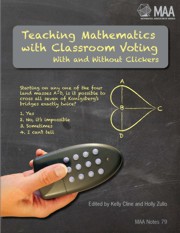Book contents
- Frontmatter
- Contents
- I An Introduction to Teaching Mathematics with Classroom Voting
- II Studies of Classroom Voting in Mathematics
- III Classroom Voting in Specific Mathematics Classes
- 6 Questions to Engage Students in Discussion (Q.E.D): Using Clickers in a Mathematics for Liberal Arts Course
- 7 Clickers in Introductory Statistics Courses
- 8 Using Clickers in a Statistics Classroom
- 9 Engaging Statistics Students with Classroom Response Systems
- 10 Incorporating Clicker Technology in the Introductory Statistics Course
- 11 Using Clickers in Courses for Future K–8 Teachers
- 12 Using Clickers in Professional DevelopmentWorkshops
- 13 Using ConcepTests in College Algebra
- 14 An Example of Multi-Purpose Use of Clickers in College Algebra
- 15 ConcepTests—Classroom Voting: A Catalyst for an Interactive College Algebra ClassroomD
- 16 Using Clickers to Encourage Communication and Self-Reflection in Precalculus
- 17 Writing and Adapting Classroom Voting Questions: New Functions from Old
- 18 Enhancing Student Participation and Attitudes in a Large-Lecture Calculus Course
- 19 Good Questions for Mathematics Eduction: An Example from Multivariable Calculus
- 20 Integrating Classroom Voting Into Your Lectures: Some Thoughts and Examples from a Differential Equations Course
- 21 Classroom Voting Questions that Provoke Teachable Moments in Differential Equations
- 22 Teaching Linear Algebra with Classroom Voting: A Class Period on Linear Independence
- 23 Lesson Planning with Classroom Voting: An Example from Linear Algebra
- 24 Using Clickers to Enhance Learning in Upper-Level Mathematics Courses
- Bibliography
- About the Editors
23 - Lesson Planning with Classroom Voting: An Example from Linear Algebra
from III - Classroom Voting in Specific Mathematics Classes
- Frontmatter
- Contents
- I An Introduction to Teaching Mathematics with Classroom Voting
- II Studies of Classroom Voting in Mathematics
- III Classroom Voting in Specific Mathematics Classes
- 6 Questions to Engage Students in Discussion (Q.E.D): Using Clickers in a Mathematics for Liberal Arts Course
- 7 Clickers in Introductory Statistics Courses
- 8 Using Clickers in a Statistics Classroom
- 9 Engaging Statistics Students with Classroom Response Systems
- 10 Incorporating Clicker Technology in the Introductory Statistics Course
- 11 Using Clickers in Courses for Future K–8 Teachers
- 12 Using Clickers in Professional DevelopmentWorkshops
- 13 Using ConcepTests in College Algebra
- 14 An Example of Multi-Purpose Use of Clickers in College Algebra
- 15 ConcepTests—Classroom Voting: A Catalyst for an Interactive College Algebra ClassroomD
- 16 Using Clickers to Encourage Communication and Self-Reflection in Precalculus
- 17 Writing and Adapting Classroom Voting Questions: New Functions from Old
- 18 Enhancing Student Participation and Attitudes in a Large-Lecture Calculus Course
- 19 Good Questions for Mathematics Eduction: An Example from Multivariable Calculus
- 20 Integrating Classroom Voting Into Your Lectures: Some Thoughts and Examples from a Differential Equations Course
- 21 Classroom Voting Questions that Provoke Teachable Moments in Differential Equations
- 22 Teaching Linear Algebra with Classroom Voting: A Class Period on Linear Independence
- 23 Lesson Planning with Classroom Voting: An Example from Linear Algebra
- 24 Using Clickers to Enhance Learning in Upper-Level Mathematics Courses
- Bibliography
- About the Editors
Summary
Introduction
Planning a lesson with classroom voting requires many of the same strategies as planning a lesson to be delivered through a lecture. First and foremost, a good lesson plan begins with a clear set of goals, and those goals must be kept in mind as the lesson is developed. Of course, the material must be approached in a logical order. Finally, a bit more flexibility is needed in a classroom voting lesson plan than a traditional lesson plan, since any given discussion can run much longer or shorter than anticipated.
Not too long ago, teaching with classroom voting involved the time-consuming process of writing questions for each class period. Now several people have made their questions available as public libraries (see the links at mathquest. carroll.edu/resources.html), saving the newcomer vast amounts of time. However, working with a large library poses a different set of problems when planning a lesson, in that there are often so many excellent questions that there is not time to use all of them. This, then, leaves us in the familiar situation of having so much that we want to share with our students about a particular topic that we are forced to pick and choose. If we do not choose carefully, then we spend valuable class time on ideas that may be a lot of fun and interesting, but which are not central to our course goals.
- Type
- Chapter
- Information
- Teaching Mathematics with Classroom VotingWith and Without Clickers, pp. 153 - 158Publisher: Mathematical Association of AmericaPrint publication year: 2011



